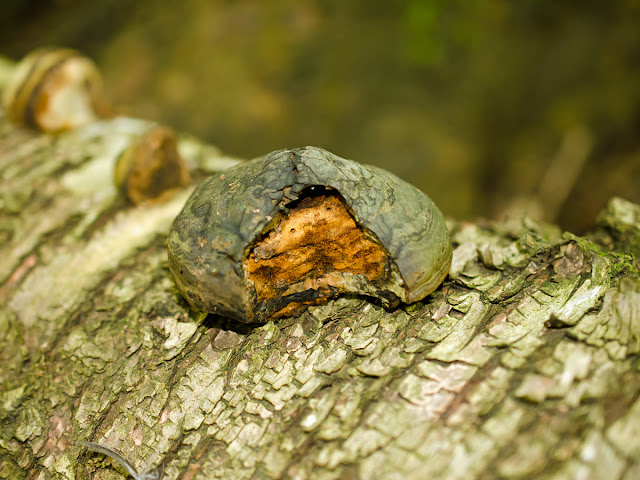*
Definitions
The
Watershed Park in Delta is a mixed forest, evergreens and deciduous trees, crawling down a steep slope between upper Delta and the low, flat farm lands beneath. It is not over-managed; occasionally, someone cuts up trees that have fallen over the paths. Dozens of trees are dead, providing well-used woodpecker feeding and perching spots. Logs not on paths molder and rot; shelf fungus and turkey tail fungus colonize them end to end.
The space beneath the trees harbours both native and invasive plants. The natives:
salal, evergreen ferns,
salmonberry,
red huckleberry, our
trailing blackberry, an abundance of mosses and mushrooms. Along the sunny bottom path, stinging nettles,
touch-me-nots, and bog plants such as
Labrador tea make a dense green wall. The invaders include Himalayan blackberry and English ivy; this year, I noticed a large patch of spotted dead nettle, which is capable of over-running even the ferns.
Spring and fall, after a few rains, we go mushrooming there.
This time, we found few mushrooms; maybe we're too early. Or too late; the weather has been unseasonably warm. We weren't disappointed, though:
Rotting snag, with frass and slime mold
Perhaps because of the warm, wet weather this winter, we found that a surprising number of the trees and snags were losing great slabs of bark; it was cracked and rotted, separated from the tree itself.
Inner side of a flap of bark: frass and small grey slime molds
Some of the old stumps were so rotten that they fell apart, or even fell over, with a touch of a finger. And behind the crumbled bark, and inside the mushy remains of the stumps, small critters feed on the molds and wood. We explored a few of these stumps and snags.
Innards of a still more or less intact stump
Insect tunnels. Can you find the wood bug?
There were wood bugs everywhere; they fell off every piece of bark we moved, out of every crevice we opened. Climbing over a log, I grabbed a branch to steady myself; it crumbled in my hand. And from its stub, a stream of wood bugs poured, like water from a tipped glass. Most were gone by the time I'd crossed the log and clambered up close to the tree, but the hole was still pretty full:
Woodbug convention centre?
More wood bugs.
Then there were the millipedes:
Millipede on frass on inner side of bark.
A pair of millipedes. The crumbs are the remains of millipede meals; dead wood.
I saw several woven white egg casings; I assumed they were made by spiders:
These were about 1/2 inch long. But what is that black thing underneath?
Hacklemesh Weaver spider. With egg case; or is it a shelter?
I saw one of these in a pile of sawdusty frass, but it scooted down a hole before I got a decent photo. I hadn't even seen this one; it was on the shady side of the tree, and the photo was too dark until I lightened it 'way up. I've never seen a spider like this before, with blue tints and pink - pink! - joints on the legs. And what seems like far too many legs.
I sent my few lousy photos (this was the best of the lot) to
BugGuide. And overnight,
Lynette Schimming managed to identify it for me, at least down to the family. Yay, BugGuide! And thanks, Lynette!
It's a Hacklemesh Weaver spider, of the family Amaurobiidae.
Most amaurobiids occur in cryptozoic habitats on the forest floor, in and under decomposing logs, in leaf litter, and under rocks. Some... are found in the bark cavities of standing trees and others have been recorded from rocky grasslands, buildings and caves. From BugGuide.
The "many legs" are really the regular 8, but the spider holds them tightly together over it's back (so did the first one I saw), so that they look as if they crossed over each other. (See
this one, from Colorado.)
One other bug; another that we didn't see until we looked over the photos. On a shelf mushroom, one of a crowd on a rotting log, we found this cute globular springtail:
Quite large, for a springtail.
Oh,
frabjous day!
*Definitions of title vocabulary, from Jabberwocky,
here (Wikipedia).























































